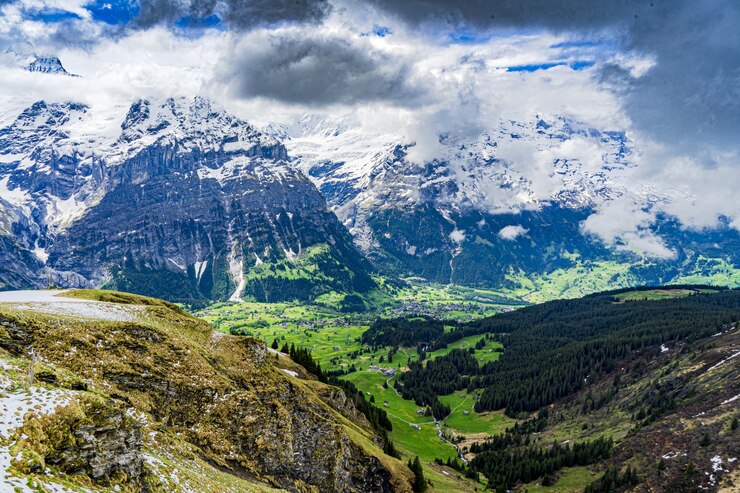There’s something undeniably magical about mountain valleys. Nestled between towering peaks and characterized by their lush greenery, crystal-clear rivers, and untouched beauty, these natural wonders have long been celebrated by nature lovers, adventurers, and travelers seeking respite from the chaos of everyday life. Featured prominently in publications like the New York Times (NYT), mountain valleys continue to captivate hearts with their pristine landscapes, quiet charm, and abundant opportunities for outdoor exploration. But what makes these valleys so enchanting? And why do they continue to inspire countless stories and travels?
A Journey Into the Heart of Mountain Valleys
Mountain valleys are nature’s havens—vast, fertile depressions nestled between steep mountains that often serve as the cradle of life for ecosystems, rivers, and human settlements. They offer a perfect balance of dramatic scenery and serenity, where the hustle and bustle of urban life seems a world away. Whether carved by glaciers or formed by river erosion over millennia, these valleys boast a unique blend of geology, ecology, and culture, making them some of the most sought-after destinations for travelers and adventurers alike.
According to several features published in the NYT, mountain valleys are often hailed for their ability to soothe the soul and offer unparalleled natural beauty. From the winding trails and hidden waterfalls to the panoramic vistas that take your breath away, each valley offers something unique for everyone. Whether you’re a seasoned hiker, a photography enthusiast, or simply someone seeking tranquility, the allure of these landscapes is impossible to resist.
The Allure of Solitude and Adventure
One of the most prominent appeals of mountain valleys, as highlighted by the NYT, is the delicate balance they offer between adventure and solitude. These landscapes are not just picturesque settings; they invite exploration, whether through hiking, biking, camping, or even meditative walks along meandering rivers.
Hiking through a mountain valley is an experience unlike any other. As you traverse steep trails surrounded by towering peaks, the sound of rushing streams and chirping birds becomes a constant companion. The diverse terrain—ranging from dense forests to alpine meadows—promises varied adventures with each new step. Whether you’re embarking on a multi-day trek or enjoying a leisurely day hike, the beauty of mountain valleys reveals itself in both grand vistas and minute details.
The NYT frequently showcases some of the world’s most famous valleys—from the iconic Yosemite Valley in the United States to the verdant Val di Funes in the Italian Dolomites. These valleys not only offer exceptional natural beauty but also opportunities for spiritual reflection. The sheer scale of the mountains and the wide expanse of the valleys can evoke a deep sense of awe and humility, making these destinations ideal for those seeking both physical and mental rejuvenation.
Mountain Valleys as Ecological Treasures
Mountain valleys are more than just scenic wonders; they are vital ecosystems that support a rich diversity of plant and animal life. Due to their unique topography and climate, valleys often harbor species that are found nowhere else on Earth. As climate change continues to affect global ecosystems, the role of mountain valleys as ecological sanctuaries becomes even more critical.
According to environmental features in the NYT, many mountain valleys are home to fragile ecosystems that require conservation and protection. Valleys act as corridors for wildlife, allowing animals to move between different habitats and elevations. They also serve as important water sources, with glacial melt and rainfall feeding rivers that nourish the valleys and the communities that depend on them.
In regions like the Swiss Alps, the Peruvian Andes, or the Himalayas, local efforts to preserve these natural treasures are gaining momentum. Travelers are encouraged to engage in eco-friendly tourism, ensuring that their footprints leave as little impact as possible on the delicate ecosystems they visit. The NYT has often emphasized that responsible travel is key to preserving the beauty of these mountain valleys for future generations.
Cultural Significance of Mountain Valleys
Mountain valleys have also been at the heart of human civilization for centuries. They have provided shelter, resources, and sustenance to many indigenous communities across the globe. The connection between humans and mountain valleys goes beyond physical sustenance—it extends to cultural and spiritual significance.
For example, the NYT has chronicled stories of indigenous communities in the Himalayas, where valleys serve as sacred sites for prayer, ritual, and festivals. Many valleys in Europe, such as those in Switzerland or Austria, are steeped in centuries-old traditions, from agricultural practices to seasonal festivals celebrating the land’s bounty. The unique microcultures that develop in these isolated regions offer travelers a rare glimpse into a way of life that has remained largely unchanged for generations.
Moreover, mountain valleys often serve as critical trade routes. Historically, they have connected regions and facilitated the movement of goods, people, and ideas across challenging terrains. This dual role of being both isolated and connected has shaped the distinct cultural identities of many valley communities, which retain a strong sense of place while also being open to outside influence.
Famous Mountain Valleys Featured in the NYT
The New York Times has highlighted some of the most iconic mountain valleys from around the globe, each offering its own unique charm and allure. Here are a few notable valleys that have captured the imagination of travelers and writers alike:
- Yosemite Valley, California, USA: Perhaps one of the most famous valleys in the world, Yosemite’s grandeur is unparalleled. Towering granite cliffs, including the iconic El Capitan, rise above lush meadows and cascading waterfalls. Featured frequently in the NYT, Yosemite is a haven for both adventurers and those seeking spiritual connection with nature.
- Val di Funes, Dolomites, Italy: Known for its rolling green meadows framed by the jagged peaks of the Dolomites, Val di Funes is a photographer’s dream. The quaint mountain villages nestled within the valley provide a perfect backdrop to this stunning landscape. The NYT has often described this region as one of Europe’s best-kept secrets.
- Zanskar Valley, Himalayas, India: Zanskar Valley is a remote and stunning valley located in the Indian Himalayas. It is famed for its rugged beauty, isolation, and the unique culture of its inhabitants. The valley is home to Tibetan Buddhist monasteries, towering cliffs, and icy rivers, and it offers some of the most challenging treks in the world.
- Lauterbrunnen Valley, Switzerland: With its picturesque villages, towering waterfalls, and lush green pastures, Lauterbrunnen Valley epitomizes the Swiss Alpine experience. It is frequently highlighted by the NYT as one of the most idyllic and serene spots in Europe, perfect for both winter sports enthusiasts and summer hikers.
- Sacred Valley, Peru: Known for its rich Incan history, the Sacred Valley is a stunning region of the Andes Mountains. Ancient archaeological sites, including the famous Machu Picchu, are scattered throughout the valley, drawing thousands of visitors each year. The NYT regularly covers the Sacred Valley for its blend of history, culture, and natural beauty.
Mountain Valleys and Wellness Tourism
The tranquil settings of mountain valleys have made them popular destinations for wellness tourism. From yoga retreats to meditation workshops, these serene landscapes provide the perfect environment for healing both body and mind. Wellness travelers often seek out mountain valleys as places where they can disconnect from the stresses of modern life and reconnect with nature.
In recent years, features in the NYT have highlighted the growing trend of wellness-focused travel in mountain valleys. Many resorts and lodges nestled in these valleys now offer wellness programs, including guided hikes, spa treatments, and mindfulness practices that take advantage of the peaceful surroundings. The combination of fresh air, natural beauty, and physical activity makes these valleys ideal destinations for those looking to rejuvenate their health and well-being.
The Future of Mountain Valleys
As climate change continues to alter landscapes around the globe, mountain valleys face both challenges and opportunities. The NYT has frequently reported on the impact of rising temperatures on glaciers, biodiversity, and water sources in these regions. At the same time, there is a growing movement to protect and preserve mountain valleys through sustainable tourism, conservation efforts, and eco-friendly practices.
Looking forward, it is clear that mountain valleys will continue to inspire awe and wonder in those who visit them. Their timeless beauty, combined with their ecological and cultural importance, makes them places worth protecting and cherishing for generations to come.
FAQs
What is a mountain valley?
A mountain valley is a low area between mountains, often formed by rivers or glaciers. These valleys are known for their natural beauty, biodiversity, and significance as ecosystems.
Why are mountain valleys important for biodiversity?
Mountain valleys support a wide range of plant and animal life, often acting as corridors for wildlife to move between different elevations and habitats. They are also crucial for water supply and ecosystem services.
Which mountain valleys are famous for tourism?
Famous valleys include Yosemite Valley in the USA, Val di Funes in Italy, Lauterbrunnen Valley in Switzerland, and the Sacred Valley in Peru. Each of these destinations offers a unique blend of natural beauty and cultural significance.
How does climate change affect mountain valleys?
Climate change impacts mountain valleys through rising temperatures, which can lead to glacial melting, changes in biodiversity, and altered water systems. These changes threaten both the ecological balance and the human communities that rely on these regions.
Why are mountain valleys ideal for wellness tourism?
The natural beauty, fresh air, and peaceful atmosphere of mountain valleys make them perfect for wellness tourism. Many retreats in these areas offer activities like yoga, meditation, and hiking to promote mental and physical health.
How can travelers contribute to the conservation of mountain valleys?
Travelers can support conservation by practicing eco-friendly tourism, minimizing their environmental impact, and supporting local communities through responsible travel choices.
Conclusion
Mountain valleys, with their breathtaking landscapes, rich biodiversity, and cultural significance, represent some of the most beautiful and important places on Earth. As the New York Times has often pointed out, these valleys are more than just travel destinations; they are sanctuaries of peace, adventure, and ecological importance. By exploring and protecting these natural wonders, we ensure that future generations will be able to experience the magic of mountain valleys for themselves.










